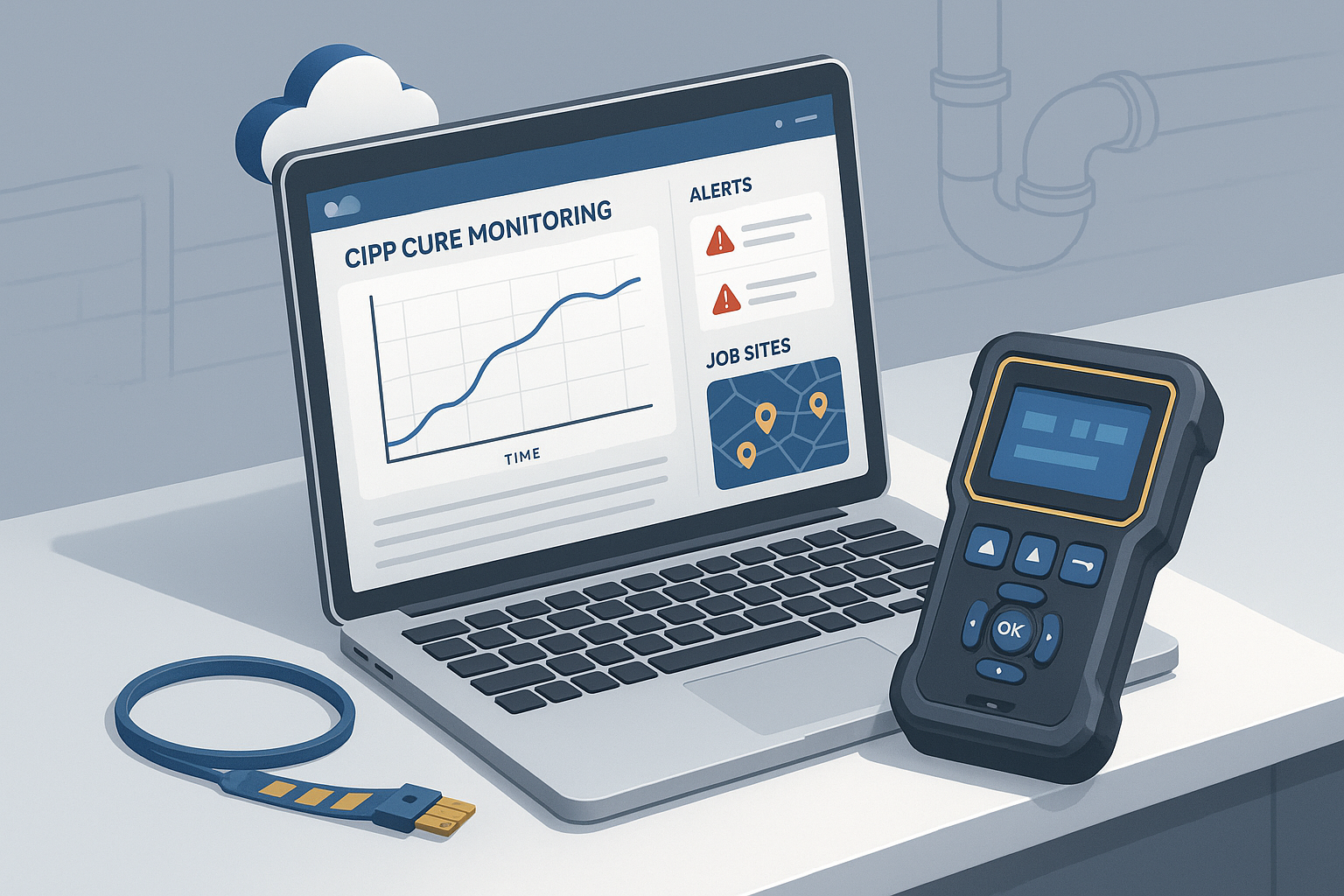Cloud Cure Data for CIPP: Why It Pays on Every Job

Cloud-based data eliminates guesswork in CIPP and pays back in fewer delays.
What continuous cure data reveals that spot checks miss
In CIPP, what you can’t see can hurt your schedule and your budget. Spot checks—like occasional thermometer readings or end-of-cure “rock tests”—miss the moving heat front that determines whether resin fully polymerizes at the liner/host interface. A single cold pocket or premature cool-down can force rework, add days of delay, and trigger disputes. Cloud-connected cure data fixes that by giving crews and owners continuous, verifiable evidence of what happened inside the pipe—every inch of the way. Continuous temperature profiles and pressure logs provide a high-fidelity picture of the cure from inversion to acceptance. Instead of relying on anecdote or memory, teams make decisions from objective, time-stamped data aligned to specifications and standards such as ASTM F1216. Industry coverage increasingly frames cure monitoring as a cornerstone of QA/QC; for example, see this primer in Trenchless Technology: Cure Monitoring Article. Cloud data adds three advantages over standalone loggers. First, it enables real-time oversight—the moment a sensor shows a lagging crown, supervisors can slow a UV train or adjust steam flow before the window closes. Second, it creates a tamper-resistant, permanent record that simplifies submittals, closeout, and training. Third, it supports multi-party collaboration: engineers, inspectors, and manufacturers can see the same dashboard, reducing miscommunication. CureView is a patented, cloud-based cure monitoring system designed for the realities of CIPP. A durable sensor strip measures temperature at the pipe-liner interface, a handheld controller initiates and monitors the cure, and the cloud portal stores and visualizes the entire run. Learn more: CureView.
How cloud platforms cut risk, delays, and disputes
A cloud-native approach adds resilience, speed, and objectivity across the project lifecycle. - Real-time oversight and faster interventions: Centralized dashboards with alerts for minimum interface temperature, hold time, and pressure windows allow supervisors—or even manufacturer reps—to assist remotely the moment a curve drifts. That saves minutes when they matter most. - Proof for acceptance and claims: Time-stamped, tamper-resistant logs simplify submittals and closeout. Instead of stitching together screenshots, crews share a single dataset aligned to chain-of-custody requirements. This is invaluable when owners must demonstrate conformance to standards like ASTM F1216 and internal QA/QC policies. - Institutional knowledge and training: A cloud archive lets teams benchmark jobs across diameters, hosts, and cure methods (steam, hot water, UV) to refine set points and installation tactics. Over time, this becomes the backbone of your standard work. - Lower total risk: Permanent records reduce the likelihood of disputes. If questions arise—a cold crown, a lamp speed adjustment, or a pressure fluctuation—the data shows exactly what happened and when. Industry press continues to stress the value of cure monitoring as part of QA/QC; see this overview: Cure Monitoring Article. - Community and safety considerations: For projects using styrenated systems near buildings, transparent documentation supports outreach and compliance with local health advisories (e.g., Florida DOH and EPA’s styrene background: EPA Fact Sheet), while non-styrene options can be documented in resin submittals. Operationally, cloud platforms also streamline multi-party collaboration: engineers, inspectors trained through NASSCO ITCP, contractors, and manufacturers can see the same data, decreasing miscommunication and expediting approvals.
CureView in practice: workflows, ROI, and compliance
CureView translates the principles above into field-ready workflows. - Before the job: Define cure targets and acceptance criteria. In CureView, set project metadata (segment IDs, diameter, host material, resin type) and alarm thresholds for minimum interface temperature, hold times, and pressure windows. Prepare the sensor strip length to match the design reach and verify calibration. - During the cure: Affix the sensor strip along the liner to capture temperatures at the liner/host interface. Use the handheld controller to initiate logging. The dashboard visualizes the advancing heat front and hold periods, and flags deviations. Supervisors can watch on-site via the controller and remotely via the cloud portal. - If conditions drift: When a cold spot appears (e.g., crown lagging invert), the system’s alerts prompt adjustments (flow rates, boiler set points, or lamp speed for UV systems). All actions are time-stamped alongside sensor data to maintain an objective record. - After the cure: Export the complete dataset and combine it with post-CCTV. Owners receive a single acceptance package with verifiable cure traces. This reduces back-and-forth and accelerates payment milestones. ROI considerations - Avoided rework: Preventing even one failed segment offsets the cost of instrumentation many times over when you tally resin, liner, traffic control, and crew time. - Compressed schedules: Faster decisions and fewer relaunches shrink critical path. - Stronger reputation and fewer claims: Objective data defuses disagreements. For product background and capabilities, visit the CureView page: CureView. Trade coverage on cure monitoring’s role in QA/QC provides additional context: Trenchless Technology.
